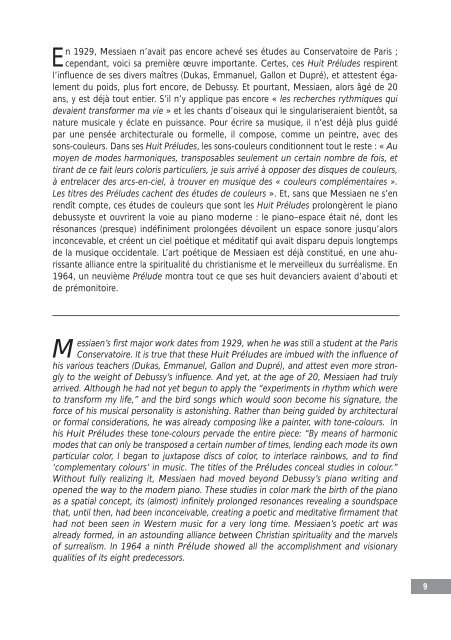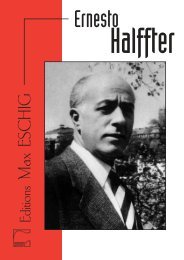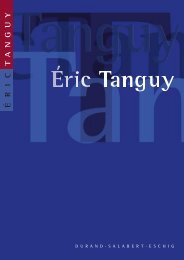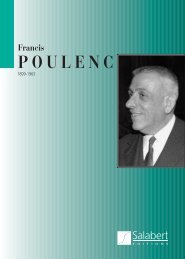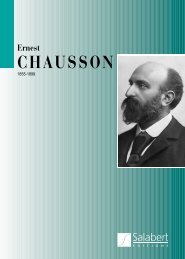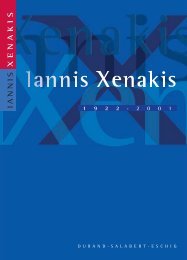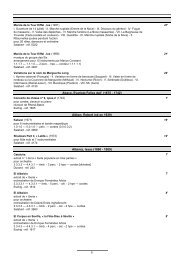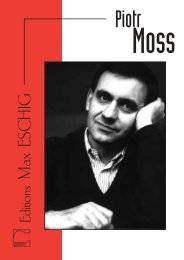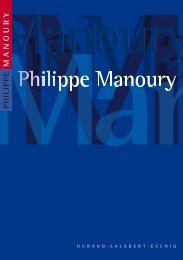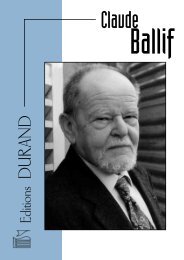messiaen olivier 1 9 0 8 - Durand Salabert Eschig
messiaen olivier 1 9 0 8 - Durand Salabert Eschig
messiaen olivier 1 9 0 8 - Durand Salabert Eschig
Create successful ePaper yourself
Turn your PDF publications into a flip-book with our unique Google optimized e-Paper software.
E n 1929, Messiaen n’avait pas encore achevé ses études au Conservatoire de Paris ;<br />
cependant, voici sa première œuvre importante. Certes, ces Huit Préludes respirent<br />
l’influence de ses divers maîtres (Dukas, Emmanuel, Gallon et Dupré), et attestent également<br />
du poids, plus fort encore, de Debussy. Et pourtant, Messiaen, alors âgé de 20<br />
ans, y est déjà tout entier. S’il n’y applique pas encore « les recherches rythmiques qui<br />
devaient transformer ma vie » et les chants d’oiseaux qui le singulariseraient bientôt, sa<br />
nature musicale y éclate en puissance. Pour écrire sa musique, il n’est déjà plus guidé<br />
par une pensée architecturale ou formelle, il compose, comme un peintre, avec des<br />
sons-couleurs. Dans ses Huit Préludes, les sons-couleurs conditionnent tout le reste : « Au<br />
moyen de modes harmoniques, transposables seulement un certain nombre de fois, et<br />
tirant de ce fait leurs coloris particuliers, je suis arrivé à opposer des disques de couleurs,<br />
à entrelacer des arcs-en-ciel, à trouver en musique des « couleurs complémentaires ».<br />
Les titres des Préludes cachent des études de couleurs ». Et, sans que Messiaen ne s’en<br />
rendît compte, ces études de couleurs que sont les Huit Préludes prolongèrent le piano<br />
debussyste et ouvrirent la voie au piano moderne : le piano–espace était né, dont les<br />
résonances (presque) indéfiniment prolongées dévoilent un espace sonore jusqu’alors<br />
inconcevable, et créent un ciel poétique et méditatif qui avait disparu depuis longtemps<br />
de la musique occidentale. L’art poétique de Messiaen est déjà constitué, en une ahurissante<br />
alliance entre la spiritualité du christianisme et le merveilleux du surréalisme. En<br />
1964, un neuvième Prélude montra tout ce que ses huit devanciers avaient d’abouti et<br />
de prémonitoire.<br />
Messiaen’s first major work dates from 1929, when he was still a student at the Paris<br />
Conservatoire. It is true that these Huit Préludes are imbued with the influence of<br />
his various teachers (Dukas, Emmanuel, Gallon and Dupré), and attest even more strongly<br />
to the weight of Debussy’s influence. And yet, at the age of 20, Messiaen had truly<br />
arrived. Although he had not yet begun to apply the “experiments in rhythm which were<br />
to transform my life,” and the bird songs which would soon become his signature, the<br />
force of his musical personality is astonishing. Rather than being guided by architectural<br />
or formal considerations, he was already composing like a painter, with tone-colours. In<br />
his Huit Préludes these tone-colours pervade the entire piece: “By means of harmonic<br />
modes that can only be transposed a certain number of times, lending each mode its own<br />
particular color, I began to juxtapose discs of color, to interlace rainbows, and to find<br />
‘complementary colours’ in music. The titles of the Préludes conceal studies in colour.”<br />
Without fully realizing it, Messiaen had moved beyond Debussy’s piano writing and<br />
opened the way to the modern piano. These studies in color mark the birth of the piano<br />
as a spatial concept, its (almost) infinitely prolonged resonances revealing a soundspace<br />
that, until then, had been inconceivable, creating a poetic and meditative firmament that<br />
had not been seen in Western music for a very long time. Messiaen’s poetic art was<br />
already formed, in an astounding alliance between Christian spirituality and the marvels<br />
of surrealism. In 1964 a ninth Prélude showed all the accomplishment and visionary<br />
qualities of its eight predecessors.<br />
9


